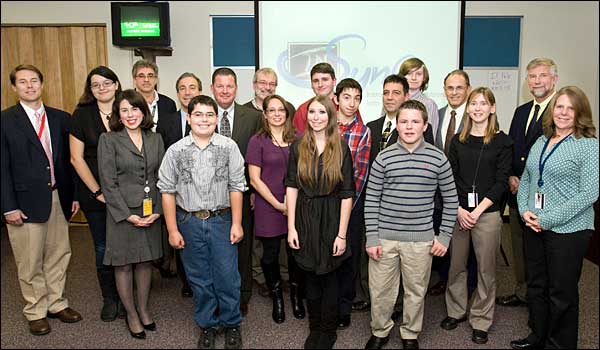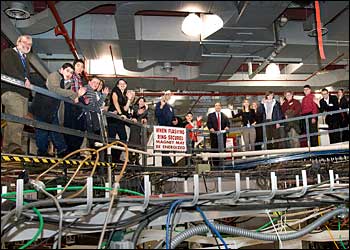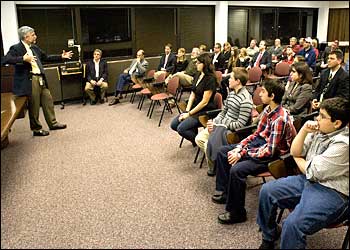First Beam Time Allocated to Local Classrooms through InSynC Program
December 8, 2010
Students and teachers from three Long Island classrooms will add one major piece of equipment to their scientific toolbox this winter: Brookhaven National Laboratory’s National Synchrotron Light Source (NSLS). Research proposals from Elwood-John Glenn High School, Sachem East High School, and Islip Middle School are the first approved to receive beam time under the newly developed Introducing Synchrotrons into the Classroom (InSynC) program. The teachers joined students, parents, and district administrators on November 29 for a special award ceremony, where they received a first-hand look at the massive machine they’ll use from the comfort of their classrooms.

Brookhaven staff with InSynC teachers, students, and parents
Launched last summer by NSLS and Brookhaven’s Office of Educational Programs (OEP), InSynC enables teachers and students to gain remote access to NSLS through a competitive, peer-reviewed proposal process. The program drew 17 middle school and high school science teachers to Brookhaven in July for an intensive, three-day synchrotron training workshop. At the beginning of the school year, the trained teachers worked with their students to develop scientific hypotheses that could be investigated through synchrotron techniques. In all, six InSynC research proposals were submitted to an international review panel consisting of scientists and educational program coordinators from other synchrotron facilities.

InSynC participants and parents on a tour of NSLS
The panel allocated beam time to two of the proposals. Laboratory Director Sam Aronson, Associate Laboratory Director for Photon Sciences Steve Dierker, and OEP Manager Ken White congratulated the inaugural InSynC teams at an awards ceremony held at NSLS. The event was followed by a tour of the experimental floor, where the students’ samples will soon be studied.
During the next couple of months, students from John Glenn (led by teacher Diana Soehl) and Sachem East (led by teacher Michael Vaccariello) will study how biofilms from bacteria, algae, and fungi might be used to clean up toxic levels of copper in fresh water. At the same time, Islip earth science teacher Ashley Bloch will lead her middle school students in a different type of water experiment — one that examines the effectiveness of several popular home water filters. Both experiments will be carried out using micrometer-sized x-ray beams at beamline X26A.

Associate Laboratory Director for Photon Sciences Steve Dierker congratulates the first InSynC beam time participants.
The teachers will each select a small group of students to conduct the experiment with them at NSLS. The remainder of the students will watch and participate in the study from their schools via Internet-enabled tools.
These student/teacher proposals are the first in the continuous InSynC proposal cycle. The deadline to apply for beam time this spring is January 14, 2011.
Support for InSynC is provided by the Office of Workforce Development for Teachers and Students within the U.S. Department of Energy Office of Science.
2010-2137 | INT/EXT | Newsroom









